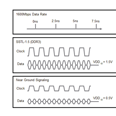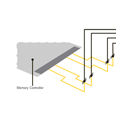Home > Emerging Solutions > Beyond DDR4

Emerging Solutions
Beyond DDR4: Next-Generation Main Memory
Focused on advancing single-ended signaling technologies to meet the memory system requirements of next-generation computing applications while maintaining compatibility with current industry standard DDR4 solutions, this next-generation R+ main memory architecture advances single-ended signaling up to 6.4 gigabits per second (Gbps) in a multi-rank, multi-DIMM system.

Improved Performance
4.8–6.4Gbps data rates with single ended signaling
Multi-rank and multi-DIMM support

Reduced Power
25% better DRAM power efficiency and zero DRAM idle power dissipation

Cost-Effective
Asymmetric design lowers DRAM cost and improved yield
Uses standard connectors, modules, IC packages and PCBs
Demand for an enriched end-user experience and increased performance in next-generation mainstream computing applications is unremitting. Driven by multi-core computing, virtualization and processor integration trends, the industry needs a next-generation main memory solution capable of achieving data rates of up to 6400Mbps in the same, or lower power envelope as current DDR4 memory solutions. The divergence of these two requirements, increasing performance while lowering power, presents a difficult challenge for future memory system designers.
In addition, next-generation memory solutions face potential bottlenecks in access efficiency and capacity, both of which have fallen as date rates increased. Memory module upgrades are the most common way to increase capacity in a system. The number of modules supported on a DDR4 memory channel drops at high data rates due to degraded signal integrity. This problem has led to a change in topology from multiple DIMMs per memory channel to a point-to-point topology that only supports a single DIMM per memory channel. This makes a DDR4 memory system difficult to scale and non-ideal for most server, workstation and high-end PCs. Memory access granularity also suffers as data rates increase due to the disparity between the interface and core access speeds. The result is an increase to the core prefetch and a sub-optimal transfer size for future multi-core and graphics computing applications.
The R+ technologies for extending main memory address these issues by enabling single-ended signaling to go beyond DDR4 in a power-efficient and cost-effective manner.
Inventions

Near ground signaling
Near Ground Signaling enables devices to achieve higher data rates and reduced power by using a single-ended, ground-terminated signaling technology that significantly improves signal integrity.Dynamic Point-to-Point
Dynamic Point-to-Point (DPP) technology combines the benefits of multi-drop and point-to-point topologies by enabling upgrade in capacity without degrading signal integrity and memory bus speed.
